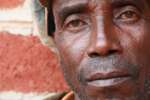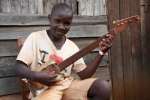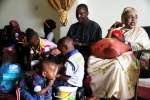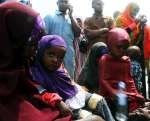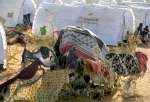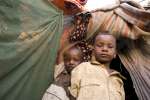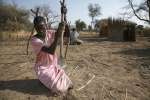Cholera containment measures stall death rate in Tanzania refugee camp
News Stories, 26 May 2015
GENEVA, May 26 (UNHCR) – The UN refugee agency reported on Tuesday that containment measures to tackle a cholera epidemic in western Tanzania's Lake Tanganyika area appear to be working. The epidemic had this month claimed 30 lives among refugees and the local community, but UNHCR spokesman Adrian Edwards said that no new deaths had been reported since last Thursday.
A death last week reported as being cholera has now been reclassified, meaning that the total cholera death toll has been revised downwards by one to 30. In all, 4,408 cases have so far been reported, but the number of new cases daily has fallen to around 100 from a peak of 915 on May 18.
"The reduction in the reported cases is largely due to the concerted approach to contain the spread of the outbreak through intensified measures to promote hygiene. For now the situation is improving, but resolving it fully may take several weeks," Edwards told journalists in Geneva.
UNHCR, the World Health Organization and other partners are working closely with the Tanzanian health authorities to ensure treatment of patients and to strengthen prevention measures, including improved access to safe water and sanitation.
A team from Médecins Sans Frontières (MSF) is running cholera treatment centres in Kagunga and supporting other partners in Kigoma. The health programme at the Nyarugusu refugee camp is being run by the Tanzanian Red Cross Society and MSF is setting up the cholera treatment centre.
The village of Kagunga, one of the epicentres for the outbreak and which until only recently was hosting tens of thousands of people, has now been almost emptied of refugees. "Around 30,000 people there have been moved to the Nyagurusu refugee camp, and we hope to complete the movements of the remaining few thousand refugees either today or tomorrow. Arrangements have begun for massive decontamination," UNHCR's Edwards said.
At the Tanganyika stadium in Kigoma, another epicentre, efforts to improve the water and sanitation situations have also been showing positive results with fewer critical cases appearing. Currently, at both Kagunga and Kigoma, there is a shortage of bed nets and malaria is still a concern.
In Nyarugusu all refugees go through vaccination for childhood illnesses, deworming and have a nutritional assessment done. Work is being done to expand the camp's capacity.
Across the region, the outflow of refugees from Burundi has not stopped, but rates are currently down to about 100 arrivals a day in each of the main receiving countries. Taking into account revised figures received by UNHCR, there are more than 90,000 Burundian refugees in the region, including 10,000 in Democratic Republic of the Congo, 47,000 in Tanzania, 28,000 in Rwanda and 5,500 in Uganda.






